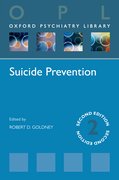By Robert Goldney, AO, MD
Each year about a million people worldwide die by suicide and an unknown number, estimated at 10 to 20 times that, engage in some form or other of life-threatening behavior. As a result, strong feelings are usually evoked in others, particularly in family and close friends.
Psychiatric practice for over 40 years has not made me immune to such feelings. As a newly graduated medical intern in 1968, two patients are still indelibly imprinted on my mind. The first was an attractive young woman with brain damage, the result of carbon monoxide poisoning following a break up with her boyfriend. Sadly, there was no hope of improvement. The other was an elderly man admitted with severe pneumonia, which when treated revealed a profoundly depressed man whose chest infection had arisen after a near fatal overdose. Surprisingly to me at that time, his depression and wish to die responded well to electro-convulsive therapy and follow-up antidepressants.
This spectrum of outcomes is all too familiar to practicing psychiatrists. Sometimes seemingly trivial issues can lead to risk-taking, death, or irreversible injury, and at times we can provide very effective treatment. The only obvious common thread for these two patients was the suicidal behavior — and there’s one of the dilemmas facing those who attempt to understand the enigma of suicide.

It is clear that there are many paths to suicide, a fact sometimes ignored by those who promote either psychosocial or biomedical causes. Such a dichotomy is not only counterproductive to good clinical practice, but it is wrong. Suicide is predominantly related to socio-economic issues in less developed countries and those with repressive political regimes, where there are poorly developed health services and inadequate social service safety nets. However, sophisticated genetic studies in developed countries have confirmed the importance of inherited factors. These are mediated by psychiatric illnesses and the optimum management of these can influence suicide.
This may seem obvious, but it is difficult to prove conclusively because of the low base rate of suicide. What this means is that although when suicide occurs it is dramatic and there may seem to be clear cut precipitants, the dilemma is that those apparent causes lack specificity. Indeed, the numbers needed to demonstrate the effectiveness of any intervention are so great that the conventional gold standard of proof, a randomized controlled trial, is impractical.
This has led to some being pessimistic about our ability to prevent suicide. However, the astute investor is aware of other investments beside gold, and there are alternative research methodologies which have convincingly demonstrated the effectiveness of suicide prevention measures. Population-based pharmaco-epidemiological studies have shown a reduction in suicide in association with increasing uptake of certain antidepressants; there is persuasive evidence for the protective effect of lithium in bipolar disorders; and recent large community studies in England have demonstrated that when a health service implements recommendations such as the provision of 24-hour crisis care, specific treatment policies for those with dual diagnoses, and multi-disciplinary reviews when suicide does occur, there is a significant fall in suicide compared to areas where such initiatives are not undertaken. Other measures such as more appropriate media reporting of suicide and prevention of access to jumping sites, firearms, or potentially lethal pesticides are also effective.
None of this is rocket science. However, some measures require persistent advocacy and political legislation, which can be frustrating to clinicians used to routinely introducing evidence-based practice. While this broad approach may be necessary, particularly in developing countries, it is important that the individual person’s distress is addressed and has the potential benefit of optimum treatment, whatever psychiatric illness may be present . Unfortunately two large studies from the UK and Australia have shown that at least 20% of suicides after contact with psychiatric services could have been prevented, if it were not for issues of inadequate assessment and treatment and poor staff communication. Long personal experience of coroner enquiries certainly confirms that.
Not all suicide can be prevented. That is particularly so when help is not sought. On other occasions suicide can be interpreted as the inevitable outcome of a malignant mental disorder, and that can be of some comfort to grieving families and friends who may be feeling guilty at their sense of relief that uncertainty is over. Clinicians may also share those emotions. However, if adequate assessment of each individual is undertaken and appropriate management pursued, on balance there will be an overall reduction in the unacceptable rate of suicide worldwide.
Robert Goldney AO, MD is the author of Suicide Prevention (Second Edition, OUP, 2013). He is Emeritus Professor in the Discipline of Psychiatry at the University of Adelaide. He has researched and published in the field of suicidal behaviors for 40 years and has been President of both the International Association for Suicide Prevention and the International Academy of Suicide Research.
Subscribe to the OUPblog via email or RSS.
Subscribe to only psychology and neuroscience articles on the OUPblog via email or RSS.
Subscribe to only health and medicine articles on the OUPblog via email or RSS.
Image credit: Autumn in Nymphenburg via iStockPhoto.




Recent Comments
There are currently no comments.